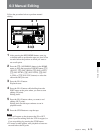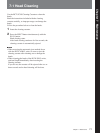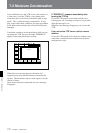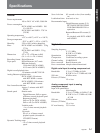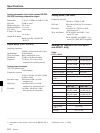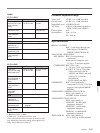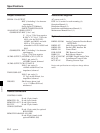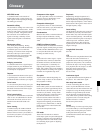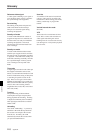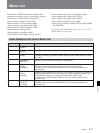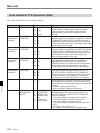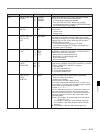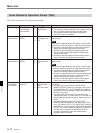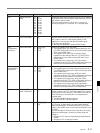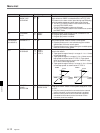
Appendix A-5
Appendix
Glossary
AES/EBU format
A standard format for the transfer of
digital audio signals. In this format, two
audio signals can be input/output through
one XLR-type connector.
Assemble editing
An edit mode for adding new scenes to the
end of previously recorded scenes. In this
mode, all video, audio, and control signals
are newly recorded. Though the result is
the coexistence of two different CTL
signals on the tape, continuity of CTL
signals at the edit points is maintained
electrically.
Backspace editing
Also called phase matching. During
backspace editing, the VTR automatically
rewinds the tape a few seconds after
recording of a scene has been completed.
This allows the tape to attain a stable
speed before the start of recording of the
next scene, thus maintaining signal
continuity during editing.
Bridging connection
A connection that allows a signal input to
an input terminal to pass throuth the unit
and exit from an output terminal for input
to a third piece of equipment.
Capstan
A drive mechanism that moves the tape at
a specified speed. Its rotation is normally
synchronized with a reference sync signal.
Color frame
A color subcarrier phase having one cycle
that consists of two frames (four fields) in
the NTSC format and four frames (eight
fields) in the PAL format.
Color frame locking
A procedure in which the time code frame
value is set to an odd number for the first
and second color fields, and to an even
number for the third and fourth color
fields.
Color framing
A method used by the VTR to maintain
continuity of the color subcarrier phase
between each two-frame cycle (NTSC) or
four-frame cycle (PAL) to avoid picture
fluctuation at edit points.
Component video signal
A video signal that consists of a luminance
signal (Y) and two chrominance (color-
difference) signals (R-Y, B-Y).
Composite video signal
A signal that consists of video (luminance
and color sub carrier), sync (horizontal and
vertical), and color burst signals.
Condensation
Moisture that collects on the head drum of
the tape transport mechanism, causing
damage to the tape and malfunction of the
VTR.
CONFI (confidence) heads
Confidence heads are additional heads that
play back signals currently being recorded.
A VTR with the CONFI heads allows you
to verify that the audio and video signals
are being recorded correctly.
CTL
Abbreviation for control signal. A pulse
signal that can be counted, to determine
the number of frames, and therefore the
tape’s running time. Used mainly for
adjusting the tracking position of video
heads, and to achieve time code continuity
during continuous recording. This signal is
recorded on a longitudinal tape track.
Cue point
A point used to mark the beginning of a
section of tape so that it can be located for
later playback or editing.
Drop frame mode
In the NTSC system, the actual number of
frames per second is approximately 29.97,
while the time code value advances one
second every 30 frames. In drop frame
mode, the time code is advaced in such a
way that this difference in the value
between real time and the time codes is
corrected. Specifically, two frames are
skipped at the beginning of each minute,
except for every tenth minute, so that the
frame value for time codes matches that
for real time.
See also Non-drop frame mode.
E-E mode
Abbreviation for Electric-to-Electric
mode. Input signals are passed through the
recorder’s electronics and output through
the output connectors. This mode is used
for confirming input signals or adjusting
the input level.
Emphasis
Emphasizing the high frequencies of a
signal before processing (pre-emphasis)
and de-emphasizing those high frequencies
before output (de-emphasis). This reduces
deterioration of the signal-to-noise ratio in
the high frequency range.
Insert editing
An edit mode for inserting new scenes into
the middle of previously recorded scenes.
In this mode, only video and audio signals
can be recorded separately. The VTR uses
the prerecorded CTL signals on the tape to
control tape travel. Therefore, before
editing can be done in this mode, CTL
signals must be recorded over the entire
length of the tape.
Longitudinal time code
See LTC.
LTC
Abbreviation for Longitudinal Time Code.
This is the time code recorded onto a
longitudinal track of the tape. During the
playback of still pictures, LTC cannnot be
read since the tape is not moving. During
slow playback, the LTC output is so small
that it may not be read correctly,
depending on the playback speed.
See also VITC.
Luminance signal
A signal that determines the brightness of
the picture. Also called the Y signal.
Non-drop frame mode
A mode of advancing the time code in
such a way that the difference in frame
values between real time and the time code
is neglected. Using this mode produces a
difference of approximately 86 seconds
per day between real time and the time
code, which causes problems when editing
programs in units of seconds using the
number of frames as a refernce.
See also Drop frame mode.
Preroll
The rewinding of a video tape in the player
or recorder VTR by a certain length before
an edit point, allowing the tape to attain a
stable speed at the edit point and
synchronization with the other video tape
during editing.



